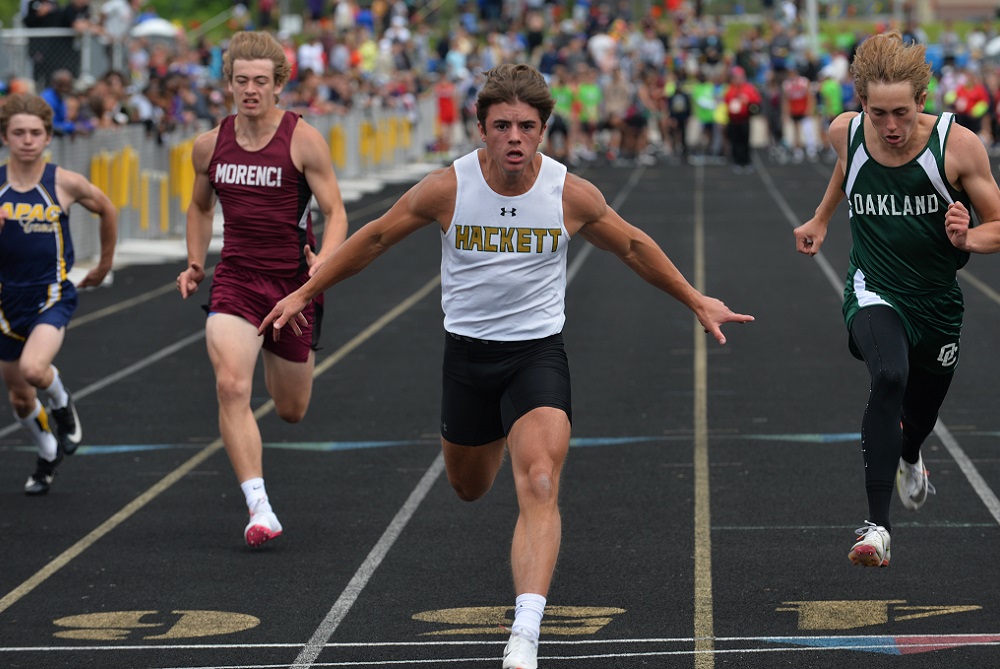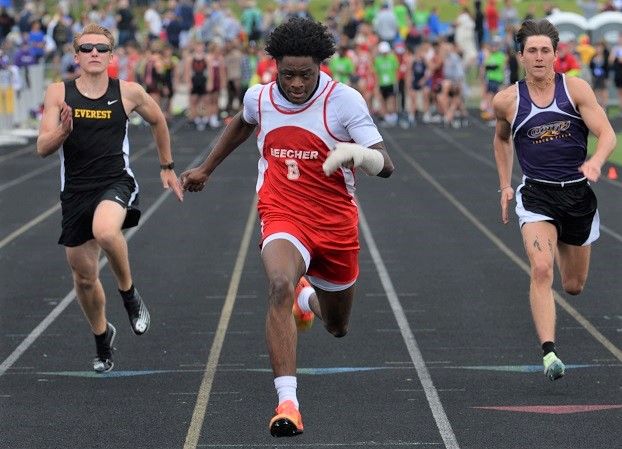
Speedy Mann Helps Make Hackett Catholic Prep Champ to Chase Again
By
Drew Ellis
Special for MHSAA.com
June 4, 2022
HUDSONVILLE – After two years away, Kalamazoo Hackett Catholic Prep is back on top of the Lower Peninsula Division 4 boys track & field world.
Using a balanced effort Saturday, the Irish held off 2021 champ Carson City-Crystal to take home the Finals hardware with 64 points. The Eagles finished with 56, while Wyoming Potter’s House Christian placed third with 45.
“Everybody came to work. We knew if we stood a chance, everyone had to get every point possible, and our guys did that,” Hackett coach Carl Scholten said of his team, which added its first title since repeating in 2018 and 2019. “This is a competitive group that has been driven to succeed all year, and this is a great culmination of all their work.”
Highlighting the day for the Irish was a 1-2-3 finish in the 200-meter dash. Junior Liam Mann took home the victory with a time of 22.82, while teammates Andrew Finley and Isaac Backman finished right behind him.
Mann was overcome with energy after the finish, so much so that he tripped and tumbled to the ground. However, the pain of the fall couldn’t overcome his joy of winning.
“I just gave it my all and as I was coming through, I started to celebrate a little bit and my legs just gave out,” Mann said of the tumble. “The race felt great. I knew I had my work cut out for me, but it felt great to win and see my teammates right there with me.”
Mann was also with Finley and Backman, and also Evan Wurtz, as the winning 800-meter relay team. The Irish finished with a time of 1:31.55. Backman came through with a championship of his own in the 400, winning with a time of 50.85.
 Along with the three event wins, Hackett had a combined six runner-up or third-place finishes on the day.
Along with the three event wins, Hackett had a combined six runner-up or third-place finishes on the day.
Carson City-Crystal came up just shy of repeating as champion, but the Eagles still had three championship performances of their own.
Michigan-bound Zane Forist finished his throwing career on a high note, resetting his LP Division 4 Finals records in both the discus (200-4) and the shot put (67-5). His shot put toss was ¾ of an inch from matching the all-Finals record.
“I really didn’t know about (the record) until today, so it wasn’t something I was really shooting for,” Forist said. “I just wanted to PR (personal record), and I did that in both of my events, so I am really happy with my performance.”
Cavanaugh Barker took home the 300 hurdles title for Carson City-Crystal with a PR time of 40.02. He also finished second in the 110 hurdles.
Potter’s House was led by distance runner Lezawe Osterink, who won championships in both the 1,600 (4:24.29) and the 3,200 (9:38.23).
“The mile was more challenging. I have to do a lot of work in the mile,” Osterink said. “I was confident going into the two-mile. I knew I just had to run my race. In the mile, I knew I couldn’t make a mistake, because there were some really fast guys in that race that could leg me out.”
Flint Beecher junior Jaylin Townsend repeated as champion in the 100 dash with a time of 10.78. Townsend managed to win despite his left hand being in a cast after breaking a finger a little over a week ago.
“I feel pretty good about how things went. I’ve had to change my block start because of the broken finger,” Townsend said of his injury, which also is on his baton-carrying hand but didn’t prevent him from anchoring two scoring relays on the day. “It affected me more mentally than it did physically. I just had to focus on getting out quick and working on my technique.”
Reading junior Tyler Bays came out a winner in the 800 run with a time of 2:00.02, while Colon’s Alexander Stoll won the 110 hurdles with a PR time of 14.92.
Buckley won the 1,600-meter relay with a time of 3:30.71, while Clarkston Everest Collegiate won the 400-meter relay in a time of 44.17.
Coleman’s Isiah Biers won the championship in the pole vault with a PR vault of 13-4. Peck’s Alex Affer won the long jump with a PR leap of 22-3.25, while Marion’s Braden Prielipp won the high jump with a PR jump of 6-9.
PHOTOS (Top) Hackett's Andrew Finley, middle, wins his 100 dash prelim Saturday. (Middle) Flint Beecher's Jaylin Townsend, also middle, wins his 100 prelim as well on the way to repeating as race champion. (Click for more from Dave McCauley/Run Michigan.)

Track Gaining Speed Toward Future with Electronic Starting Devices
By
Steve Vedder
Special for MHSAA.com
May 23, 2023
Aubrey Greenfield thinks it might be the perfect time to reevaluate 130 years of tradition.
For a number of reasons, from technical to personal, the Oxford senior sprinter believes it makes sense for the crack of a starting pistol to be eliminated from high school track meets.
Because track meets would benefit in various ways from lowering costs to easier setup at meets to the human factor of competitors not having to flinch at the crack of a pistol shot, Greenfield believes the sport has a chance to embrace new technology – electronic starting devices (ESD).
In essence, an ESD replaces the starting pistol with a light flash, tone sound or both to begin a race.
"High school sports should put the athlete first," Greenfield said. "We should promote sports, and eliminating starting pistols promotes health in terms of PTSD or trauma for athletes and spectators and that would be good. I would like to think people would say that's a good idea."
In fact, Greenfield would go as far as to say if there was not an implementation of electronic starting devices, many of her teammates would have considered giving up the sport.
"If it's something that helps us compete safely, we're all for it," she said.
Greenfield's opinion apparently is spreading. Michigan High School Athletic Association senior assistant director Cody Inglis said the use of ESD makes it both affordable for meet starters and sensible for athletes and fans to rethink the use of starting pistols. While the MHSAA is not mandating electronic starting devices, it does promote the use of what Inglis calls "emerging technology." He notes that ESD are becoming the norm for organizations such as USA Track & Field, the NCAA and an increasing number of high schools.
 "I think we have to embrace new technology, and we think this will be something that takes hold," Inglis said.
"I think we have to embrace new technology, and we think this will be something that takes hold," Inglis said.
A key part of embracing ESD is the human element. The tragic Oxford High School shooting Nov. 30, 2021, that took the lives of four students while injuring seven others should not be relived even for a fleeting instance at a high school sporting event. Oxford athletic director Tony DeMare said the school began using ESD at every meet, including the MHSAA Lower Peninsula Division 1 Finals last June. He said that decision was embraced by virtually all schools Oxford encountered.
"We were very convinced that the alternative (of ESD) would promote a healthy attitude," DeMare said. "We were overwhelmed with the positive response. If a school was on the fence about it or might not be for it, I think we've started to see the tide turn in favor of people willing to listen and learn about electronic starting devices."
Inglis said the MHSAA is acutely aware of what the crack of a starting pistol can mean to athletes and fans.
"It's unimaginable what Oxford went through, and this is a small way we can help," he said. "We look at a (starting pistol) and think, ‘Could we do something else?’ It's a way of helping to solve a problem."
Over the last several years, the MHSAA has embraced finding an alternative to starting pistols. Inglis noted the discussion started with the cost and diminishing availability of 32-caliber ammunition that meet starters use. A box of ammunition, if it can be found, is around $75 a box.
In addition to cost, there is potential damage from excessive exposure to 150-plus decibels of sound generated by the traditional 32-caliber blanks. Medical studies show damage to ears caused by decibel levels above 120 dB.
The tragedy at Oxford accelerated the conversation.
Inglis said the cost of ESD can be likened to a school sinking money into artificial surfaces at football fields. Yes, there is a great cost at first, but over time money is ultimately saved. An ESD system itself ranges between $200 and $500. Speakers also may need to be purchased, but with ESD starting events like the 800 and 1,600-meter relays positioned near the outside lanes 8, 7, 6 and 5 would result in improved hearing by athletes at the start of a race.
There is one challenge with ESD that track administrators are working to overcome – lighting conditions that lessen the ability to see the ESD’s LED light or strobe when the button is pressed by a starter to begin a race. But that vision difficulty resulting from clear blue skies and backgrounds of setting suns can be substantially improved by incorporating a black background with an ESD – something as simple as a starter holding up black cardboard behind the lighting mechanism at the start of an event.
Inglis said when all factors are considered, the use of ESD makes sense.
 "With the climate we live in nowadays, no lookalike guns is good," he said. "We're not mandating this. But people are saying this is affordable."
"With the climate we live in nowadays, no lookalike guns is good," he said. "We're not mandating this. But people are saying this is affordable."
While switching to ESD would break 130 years of tradition, the timing could be a step forward, said Jeff Hollobaugh, co-author of the book "The Fleet Feet of Spring: Michigan's High School State Championships in Track & Field." He said while no definitive answer is possible, it's likely starting pistols were used at the inaugural state meet at the Jackson Fairgounds in 1895. The meet, which included events like tossing a 16-pound shot put, bike races and a 100-meter sprint, was sponsored by the Michigan Interscholastic Athletic Association (a predecessor to the MHSAA) and comprised mostly of the state's larger schools.
Hollobaugh's sentiments echo what many involved in today's high school track & field believe in terms of making a transition from starting pistols to electronic starting devices.
"It's a change, not necessarily good or bad, just different," he said. "It's not a drastic change, but it will take some getting used to. But it is the future. In the end, we'll all be fine."
DeMare believes the future of high school track will definitely include ESD.
"Our desire is that the practicality and sensibility of this will overcome the alternative," he said. "I think we'll see the automation and electronics taking hold of certain elements in track, and people will embrace it."
PHOTOS (Top) Runners watch official Bertha Smiley as they prepare to begin a race during last season's Lower Peninsula Division 1 Finals at Rockford. (Middle) An electronic starting device provided by VS Athletics was used to start those races. (Below) Smiley sets to begin an event. (Photos provided by David Kuderka/VS Athletics.)

